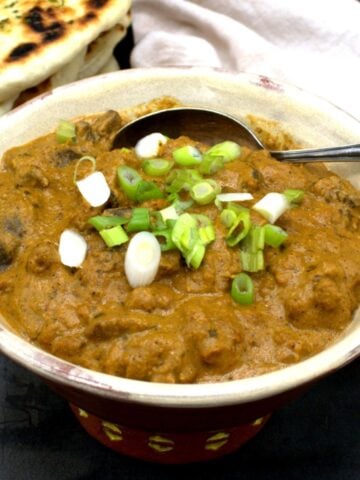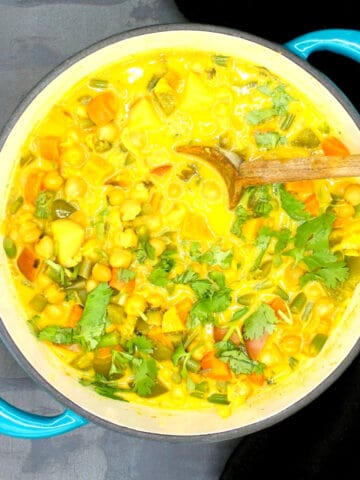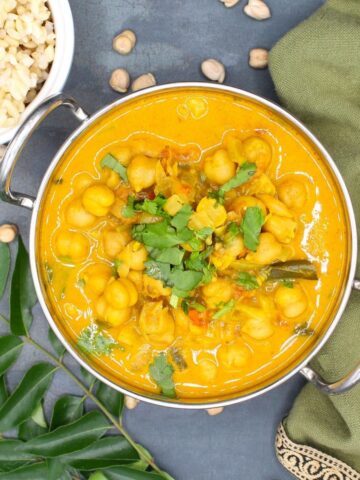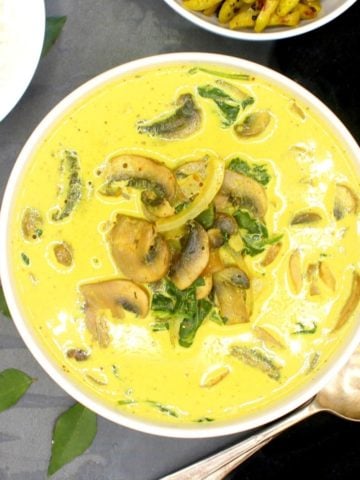You might also like vegan butter chicken, vegan Indian pepper chicken and vegan chicken masala. Here’s a really simple and ridiculously delicious vegan chicken curry that’s loaded with veggies and protein. It’s a recipe everyone I’ve ever served it to loves, including kids, but it is especially great for anyone who likes or misses eating meat.
Authentic but vegan chicken curry
The flavors in this curry are drawn from an easy south Indian Chettinad style chicken curry I used to make when I lived in India and before I started eating vegan. This was a splendid curry, with an interplay of contrasting flavors and textures. So when I veganized the recipe I made as few tweaks as possible for the best results while keeping the curry nut-free and gluten-free (the meat substitute I used this time was not soy-free, but you can find similar soy-free products on the market). The best part of that original recipe, and this one, is that you need very few ingredients. You can also add veggies like mushrooms, potatoes, summer squash - anything that won’t take too long to cook. Adding veggies also means you don’t have to serve a vegetable side if you’d rather not make the effort. Spoon the curry over steamed basmati rice and dinner is served! You will be back for seconds, and thirds. If you have my magical basic tomato onion sauce in the fridge you can make this curry even faster. I’ll include the instructions for both methods in the recipe box below. What I love about this curry - and you might too - is the combination of the spices with the smooth, sweet coconut milk. The chewy chicken bits add great texture and also bump up the protein. In fact, there are 14 grams of protein in this recipe. Serving it with a cup of cooked basmati rice bumps that protein content up to 18 grams. The dish is also low-carb-friendly, with just 12 net carbs in a serving of the curry. For heat in this vegan chicken curry recipe I use black pepper, which is more authentic in a curry of this type. The flavor of fresh-ground black pepper is also extra special when paired with curry leaves and coconut milk - a fact any south Indian can attest to. I love the flavor so I add some ground black pepper at the beginning and again at the end of the recipe. You can tweak this to your tolerance for spice. If you use the basic tomato onion sauce there is already some cayenne in the sauce, so keep that in mind and adjust the black pepper accordingly.
How to make vegan chicken curry
Store
Refrigerate: This vegan chicken curry tastes even better the next day! Store it in the fridge in an airtight container for up to five days. Freeze: You can freeze the curry for up to three months. You might find that the coconut milk gets a bit of a powdery look after freezing, but the curry should still taste great. Thaw and reheat. The curry can be reheated in the microwave or in a saucepan on the stovetop.
More yummy Indian curries
Recipe card
Vegan chicken bits or chunks
Over the years I have used different chicken substitutes in this recipe, including the Tofurkey lightly seasoned grilled chicken, which works great. This time I used 365 plant-based chicken bits which, frankly, didn’t have great flavor, but they did have a good, chewy texture. Seitan is also a good choice, and there are a number of chicken substitutes on the market now that you can choose from. If you want to make this curry without a chicken substitute, use a 14 oz can of drained chickpeas. Or use 14 oz of baked tofu or air fried tofu. Coconut oil. You can use a neutral oil in this recipe, but I like coconut oil here because its distinctive flavor works nicely in south Indian dishes like this curry and avial. Veggies: Leeks or onions (either is fine), tomatoes and mushrooms. I tossed in some orange cherry tomatoes this time but you can use a regular tomato. Herbs: Curry leaves, ginger garlic paste and cilantro. If you can’t source curry leaves, use more cilantro. Add 2 tbsps of chopped cilantro at the time you’d add the curry leaves, and add more at the end of cooking. Spices: Ground black pepper, paprika (optional) and curry powder. Coconut milk. Use canned, full-fat coconut milk. Coconut is widely eaten across south India and is a great - and authentic - addition to south Indian recipes. Tamarind paste. Tamarind has a deep, rich, sweet tanginess that’s wonderful in south Indian recipes. If you can’t source it you can use the juice of a lemon instead. A vegan cucumber raita is a delicious and cooling side. You can also serve kachumber, which is a raita minus the yogurt. If you are a dessert person, a vegan gajar halwa or vegan kheer would be spot on after this meal! Check to get new recipe updates by email.














